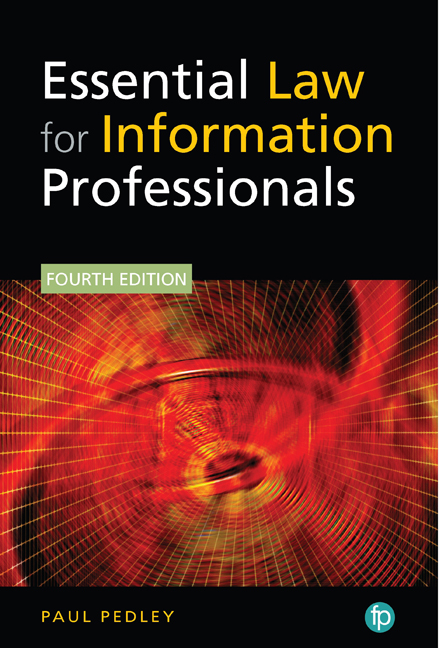Book contents
- Frontmatter
- Dedication
- Contents
- Disclaimer
- List of Figures and Tables
- Table of Statutes, Etc.
- Table of Cases
- Abbreviations
- Glossary of Terms
- Preface
- Chapter 1 General law and background
- Chapter 2 Library Law
- Chapter 3 Copyright
- Chapter 4 Legal Deposit
- Chapter 5 Breach of Confidence
- Chapter 6 Contracts and Licensing Agreements
- Chapter 7 Data Protection
- Chapter 8 Privacy
- Chapter 9 Freedom of Information
- Chapter 10 Human Rights
- Chapter 11 Re-use of Public Sector Information
- Chapter 12 Defamation
- Chapter 13 Professional Liability
- Chapter 14 Cybersecurity and Cybercrime
- Chapter 15 Disability Discrimination
- Chapter 16 Other Legal Issues Relevant to Librarians
- References
- Appendix 1 Brexit and the Orphan Works Exception
- Appendix 2 CILIP'S Ethical Framework
- Index
- Frontmatter
- Dedication
- Contents
- Disclaimer
- List of Figures and Tables
- Table of Statutes, Etc.
- Table of Cases
- Abbreviations
- Glossary of Terms
- Preface
- Chapter 1 General law and background
- Chapter 2 Library Law
- Chapter 3 Copyright
- Chapter 4 Legal Deposit
- Chapter 5 Breach of Confidence
- Chapter 6 Contracts and Licensing Agreements
- Chapter 7 Data Protection
- Chapter 8 Privacy
- Chapter 9 Freedom of Information
- Chapter 10 Human Rights
- Chapter 11 Re-use of Public Sector Information
- Chapter 12 Defamation
- Chapter 13 Professional Liability
- Chapter 14 Cybersecurity and Cybercrime
- Chapter 15 Disability Discrimination
- Chapter 16 Other Legal Issues Relevant to Librarians
- References
- Appendix 1 Brexit and the Orphan Works Exception
- Appendix 2 CILIP'S Ethical Framework
- Index
Summary
General principles
There has never been an absolute ‘right to privacy’ in English law (Wainwright v. Home Office [2003] UKHL 53). The coming into force of the Human Rights Act in October 2000 marked the implementation of the European Convention on Human Rights in the UK. The ECHR states that ‘everyone has the right to respect for his private and family life, his home and his correspondence’. But this is a qualified right, not an absolute right.
A number of the rights enshrined in the ECHR conflict with one another and there will always be a tension between them. In particular, the right to privacy (Article 8) and the right to freedom of expression (Article 10) often conflict (see Figure 8.1 on the next page). In every situation, a balance needs to be struck between those two rights and courts need to consider the issues on a case-bycase basis.
Since the HRA came into force, the courts have had to interpret existing law in ways that secure these rights. The existing law, however, remains piecemeal, and privacy complaints can be found in actions for breach of confidence, harassment, trespass, malicious falsehood and data protection legislation or pursued under regulatory codes of practice (see Section 8.3).
Privacy is a substantive right, whereas data protection is the procedural right through which privacy is achieved.
• Data protection and privacy differ both formally and substantially, although there are overlaps.
• In Europe, data protection gets more attention from policy-makers than other types of privacy.
• Data protection applies to the processing of personal data even where privacy is not infringed.
• Privacy applies both to the processing of personal and non-personal data, although data protection does not address the latter.
• Data protection is broader because it applies automatically each time personal data are processed, whereas privacy is only triggered if there has been an interference with one's right to privacy.
• The proportionality tests for the right to privacy and the right to the protection of personal data may well diverge.
Data protection concentrates on informational privacy, whereas there are several types of privacy that are worthy of protection. Koops et al. (2017) identify eight privacy types:
1 Bodily privacy.
2 Spatial privacy.
3 Communicational privacy.
4 Proprietary privacy.
5 Intellectual privacy.
- Type
- Chapter
- Information
- Essential Law for Information Professionals , pp. 177 - 188Publisher: FacetPrint publication year: 2019



